I’ve lost count of how many soft spots my dog has destroyed over time. One day, it was a plush bed, and the next, a memory foam pad that looked like snow exploded across my living room. If that sounds familiar, you already know how hard it is to find chew-proof dog beds. The struggle is real for pet owners who just want something strong enough to last.
So, I finally decided to stop wasting money. After trying many options, I researched and tested several chew-proof dog beds to see which ones could truly handle my dog’s rough play. Not all survived, but a few indestructible dog beds stood firm and quickly became my dog’s top choices. These durable dog beds not only resisted constant chewing but also stayed comfortable after months of use.
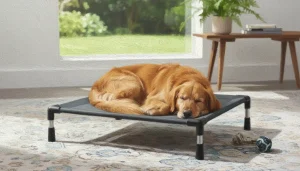
Here’s what you can expect to find in this guide:
- Why do some dogs keep chewing their beds, even when they have chew-proof dog beds?
- What makes a bed tough enough to handle those teeth
- The various chew-resistant options out there
- My top picks that have proven themselves in real life
- Tips for choosing the perfect bed for your furry companion
- Clever ways to curb destructive chewing
- Quick answers to your burning questions
Why Dogs Chew Their Beds and How Dog Beds That Are Chew-Proof Can Help?
For the longest time, I thought my dog simply had a secret mission to destroy every bed I bought. But as it turns out, dogs rarely chew for no reason — their behavior is often a clue to something deeper.
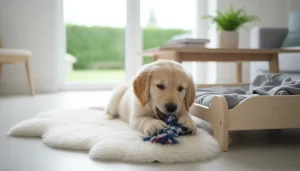
Teething Puppies: Just like human babies, puppies go through a teething phase where their gums feel sore and irritated. Chewing provides relief by massaging those tender gums and helping new teeth break through. If your puppy is in this stage, chewing isn’t misbehavior — it’s part of growing up.
Bored or Understimulated Adults: Adult dogs need both physical activity and mental stimulation. When they don’t get enough of either, they often look for ways to entertain themselves — and unfortunately, their bed becomes the target. Regular walks, interactive toys, and play sessions can help redirect that restless energy.
Anxious or Stressed Dogs: Dogs may chew when they’re anxious, lonely, or stressed by things like being left alone for long hours, changes in routine, or loud noises such as thunderstorms. The repetitive motion of chewing can actually soothe them, much like how humans fidget when nervous.
Natural Instinct and Breed Tendencies: Some breeds — like Labradors, Terriers, and Huskies — are naturally more inclined to chew due to their genetics and high energy levels. For them, chewing is an instinctive behavior that satisfies a primal urge to explore and “work” with their mouths.
What Makes Dog Beds That Are Chew-Proof Truly Durable and Long-Lasting?
Not all beds are created equal when it comes to surviving those sharp teeth. The tough ones share three key traits.
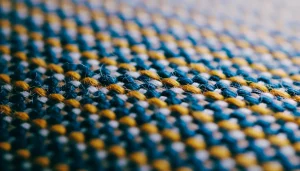
Materials That Can Take a Beating: Fabrics like ballistic nylon, reinforced canvas, or rip-stop fabric are way tougher than your average polyester. And soft cotton? That is pretty much a welcome mat for destruction.
Smart Construction: I discovered that features like hidden zippers, snug seams, and sturdy stitching really make a difference. A solid frame is essential too, especially for raised beds.
Easy Maintenance: Let’s face it: accidents are bound to happen.
Choose a chew-proof dog bed with a washable cover or an easy-to-clean fabric for quick maintenance. If cleaning feels like a chore, it is just not worth it.
Types of Chew-Resistant Sleep Options
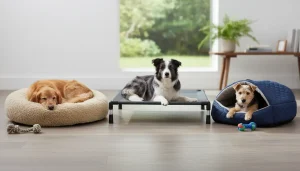
Elevated or Cot-Style Beds; These resemble little hammocks for dogs. The raised frame keeps the fabric out of reach and allows for airflow. My dog eventually gave up trying to chew the edges.
Indestructible Crate Pads: Slim yet tough. They are perfect for containers and training setups. They might not be the most stylish, but they sure are durable.
Heavy-Duty Pillow Beds: Some brands use robust outer covers with hidden stitching. These are suitable for mild chewers, but do not expect miracles with aggressive dogs.
Outdoor Choices: For pups that love to hang out in the yard, there are durable outdoor beds available. And for indoor comfort, pet cave beds for dogs offer a soft, enclosed space where your pup can relax safely and feel secure.
My Top Picks for 2025:
I tried many chew-proof dog beds, and most didn’t last—but a few were strong and really impressed me.
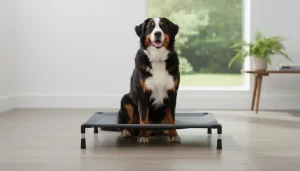
Miranda Elevated Bed: I like to call this the “tank” of dog furniture. The aluminum frame and heavy-duty fabric make it nearly indestructible.
- Best for: Heavy chewers and large breeds
- Why I like it: It lasts for years, not just weeks, and cleaning is a breeze
- Bonus: Dogs stay cooler thanks to the airflow underneath
K9 Ballistics Chew Resistant Elevated Bed: Another raised option that really stood the test. My dog tried to chew it, failed, and eventually gave up.
- Best for: Stubborn chewers
- Why I like it: No stuffing to destroy, easy to clean, and safe edges
Perfusion Ultimate Bed (Tough Cover Edition): This is not completely chew-proof, but it is a great choice for dogs that nibble occasionally. The orthopedic foam makes it excellently comfortable.
- Best for: Dogs that need joint support but still chew a bit
- Why I like it: It strikes a perfect balance between comfort and durability
How I Pick the Perfect Bed for My Dog
Choosing the right bed goes beyond just durability. Here’s how I approach it:
- Size and Breed: A Great Dane definitely needs a sturdier bed than a tiny Chihuahua.
- Chewing Habits: If your pup is a gentle nibbler, they won’t require the same level of protection as a serious chewer.
- Location: Beds for indoors can be stylish, while those for outdoors should be weather-resistant.
- Budget: Remember, price doesn’t always reflect quality. I have found that some budget-friendly options have outlasted pricier ones.
And if you are after something fun and chic, check out pink pet beds for dogs — they bring color and personality to your space while keeping your gentle chewer comfy.
Tips That Helped Curb Chewing
- Offer Alternatives: Chew toys are a game-changer. I switch them out weekly to keep my dog engaged.
- Boost Activity Levels: A tired dog behaves better. More walks and playtime can greatly reduce chewing, even on chew-proof dog beds.
- Training is key: I focused on positive reinforcement — rewarding calm behavior instead of scolding. It really made a difference.
- Tackle Anxiety: If your dog chews from anxiety, try calming aids or gentle background music—it helps protect their chew-resistant dog bed.

Extra Ideas That Made a Difference
- Frozen treats: These are great for soothing teething puppies and keeping them distracted from furniture.
- Chew deterrent sprays: Some of these taste so bad that they really help keep those teeth away from your belongings.
- Rotate Sleeping Areas: Having two beds and swapping them out occasionally has worked wonders for me — especially when mixing tough options with fun and stylish pet bed options to keep things interesting for your dog.
- Crate Training: It’s not about punishment; it’s about providing a safe space with a sturdy mat inside.
FAQs:
Are chew-proof beds indestructible?
Not entirely, but the best ones can withstand a lot more wear and tear.
Can puppies use these?
Absolutely, especially the ones that are washable.
Do big breeds need special options?
Yes, they require stronger frames and covers.
How often should I replace one?
Replace your chew-proof dog bed every 1 to 2 years, depending on how often your dog uses it.
Are raised beds comfortable?
Yes, you can add a soft blanket on top of your dog bed that is chew-proof to make it extra cozy.
Conclusion:
I’ve learned the value of investing in dog beds that are chew-proof instead of replacing flimsy ones again and again. A strong, chew-resistant dog bed saves time, money, and frustration while keeping your dog happy and relaxed. If your pup loves to chew, the Miranda Elevated Bed and K9 Ballistics Chew Resistant Bed are excellent picks for durability. However, if comfort matters most, the Perfusion Ultimate Bed is a wonderful choice.
Ultimately, chewing doesn’t mean you must buy new beds every month. If your dog enjoys enclosed comfort, consider a cozy retreat for your pup that combines safety and relaxation alongside durability.
